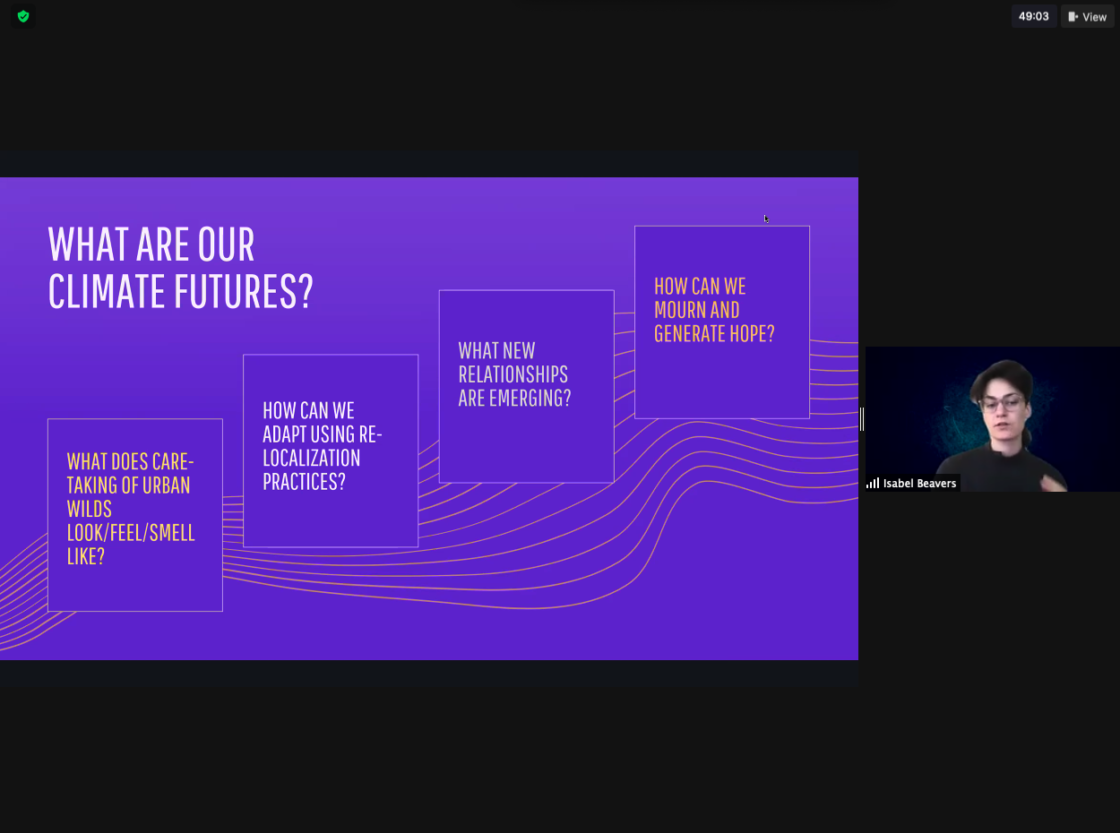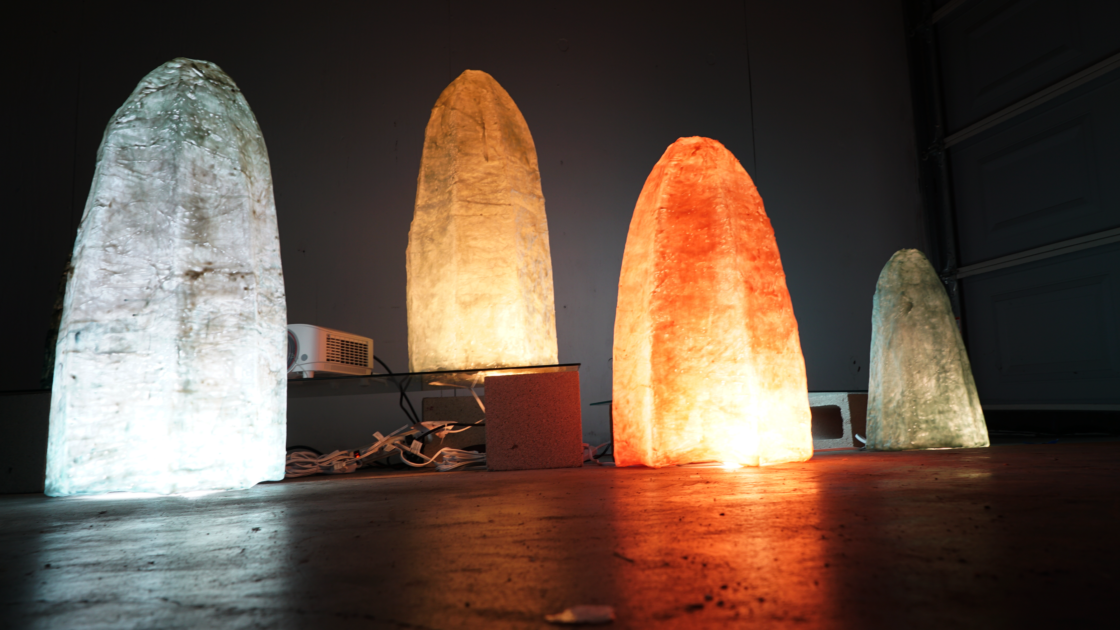Nocturne is a series of wild altars located in an urban wilderness that are meant to be experienced at dusk, dawn, or at night. The altars are experienced outdoors in chance encounters, as well as in museum and gallery exhibitions. Rooted in intimate experiences with the elements, landscape, seascape, and more-than-human species, each site calls upon a specific and ephemeral moment of sensory collaboration: times when the sun, light, sound, and scent coalesce through the senses of the human body to produce sublime or ordinary but intimate moments. The Nocturne was initiated by the LA-based artist Isabel Beavers, who has opened the project and invited others to build altars in their local urban surroundings. By welcoming others to engage in the collective, distributed practice of altar building, the Nocturne project aims to grow a relational network of more-than-human collaborations with diverse local ecosystems that offer opportunities for generating new eco-rituals.
Nocturne is an iterative and collective project while at the same time originating from a personal impulse. Inspired by portals, imaginaries, spirit worlds and the unseeable – it celebrates more-than-human species that we share the earth with.
Living in an urban environment during the pandemic spurred many outdoor walks, jaunts, journeys, explorations and observations. Driving through the xx valley I had a vision of a secret altar hidden high up in the mountains that could be accessed only via foot. Rather than asking humans to gather indoors in an art space, I wanted to bring people to site-specific locations that were ecologically significant. I was also interested in the casual and serendipitous encounter – the surprise a hiker might experience to find a favorite trail suddenly occupied by a glowing, living altar. I wanted to punctuate the experience offered by ‘nature’.
The aesthetics of Nocturne altars are important to their functioning. They are light, semi-translucent sculptures made of beeswax – as a sustainable alternative to plastics – with attached LED solar paneled lights. As the sun fades, the lanterns illuminate at dusk, forming a beacon in the dark and enticing viewers from afar as they notice a soft glow emanating from the trees. The sculptures thus generate a serendipitous moment in which the passerby notices the sculptures’ light first. The altars each spark a distinct sensorial experience: the way the sunlight backlights a native plant species at sunset; the sound of the birdsong at sunrise; the scent of jasmine leaves opening as the day cools into night.
“This pause and break in their typical movement patterns and speed are meant to lead to a moment of deeper observation of the network of more-than-human species around them. Generating this embodied experience aligns with relocalization practices, and subverts the hierarchy of intellectual versus embodied knowledge present in Western epistemologies. To come back to our bodies is to come home, and in this case to come back to the more-than-human entanglements that we are a part of. “
– Isabel Beavers (2021)
Upon spotting a wild altar, spectators also notice a QR code that has been placed. That allows them to read more about the project, and directs them to put their device away, listen, observe, and spend a few moments noticing and recognizing the lives of all of the other species that surround them. Once the first encounter with an existing altar has been made, it depends on the audience’s will and daily routines whether or not they return to the altar.
“The hope is that they plan to return or think of the altar when moving in other urban wilds throughout the city. This becomes a ritual, as participants return to the altar multiple times, or are inspired to create their own altar. This might deepen their awareness of the more-than-humans around them, inspire them to learn more about the local ecosystems, and lead to a feeling of wellbeing, connection, and eventually attunement to one’s community.”
– Isabel Beavers (2021)
The Nocturne project is an experiment in care-taking, new rituals, and a seduction into intimate moments with the more-than-human world. The practice of generating new ceremonies and rituals with more-than-human species serves as a method of re-localization, de-emphasizing the human-human connection, and re-emphasizing the grounding impacts of human-more-than-human interactions. The network of altars operates as an economy of care – visitors to the interventions are responsible for upholding the integrity of the site, both in the more-than-human species that inhabit it, as well as care-taking of the art piece and altar.
Within the CreaTures project scope, Nocturne has been showcased on several public engagement occasions. Participants of the Nocturne Altar Hack: Wild Designs for New Eco-rituals workshop at the CreaTures Feral track at the 2021 Uroboros festival discussed the possibilities of building altars in their diverse geographical locations. Participants were broken up into small groups to brainstorm how they might create a wild altar – what materials would they use, where would the altar be, what would eco-ritual would emerge from the intervention? This online workshop entangled participants from many parts of the globe and provided an enriching dialogue around ritual, ecology, and adaptation.
The second workshop Co-Creating Wild Altars organised at CultureHub’s ReFest involved participants in creating small light sculptures at the artist’s home studio. Twelve participants joined and created their own small altar. They took these home to place in their own home environment. Participants learned the process of creating these small wax sculptures and dedicated their altar to a new eco-ritual they hoped to enact.
The Nocturne: Sea Altar installation created for the Atmospheres Deep exhibition in the San Luis Obispo Museum of Art with SUPERCOLLIDER offered glimpses into the depth of ocean creatures’ entanglements. The installation includes 7 light sculptures, an audio-generated animation, and a sound piece. The animation is projected onto the ceiling of the gallery to mimic light coming through the surface of the water down into the water column. Nocturne: Sea Altar honors the ocean through a multimedia installation incorporating audio, audio-reactive visuals, and light sculptures. The work meditates on the criticality of sea diatoms for life in our oceans and asks us to engage in a practice of deep listening to ask: what are more-than-humans telling us?
An iteration of Sea Altar was further produced for the showcase at Sui Generis: Debates about the Singular exhibition, SOLA Contemporary, CA. The altar was adjusted for the space and incorporated new larger sculptures. The Nocturne Wild Altar showcased over six months on the Radio Walk Stairs in Silverlake, CA then invited passersby to experience the altars in their own time and pace. The author took participants, mostly local neighbourhood residents, on several guided tours around the diverse altars installed.
The Nocturne is an ongoing project. Upcoming exhibitions and events include a Nocturne Sea Altar showcase at the Symbiosis: Sculpting the Art of Living Together exhibition, CultureHub LA; starting on July 9th, 2022.














